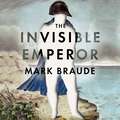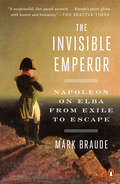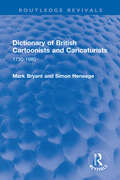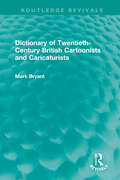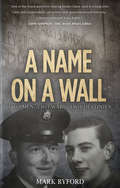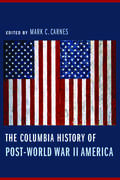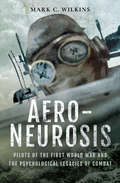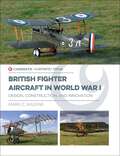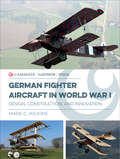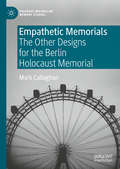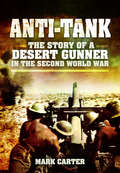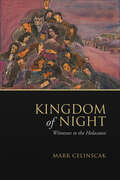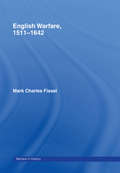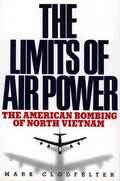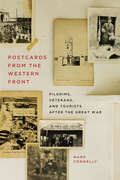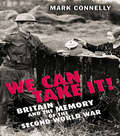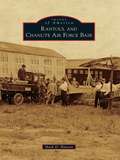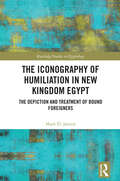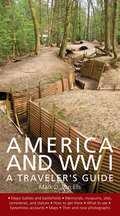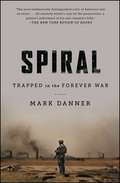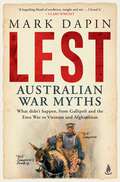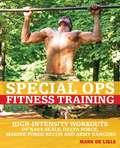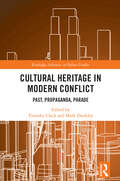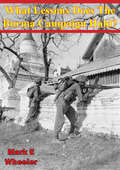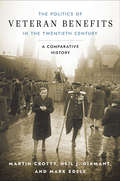- Table View
- List View
The Invisible Emperor: Napoleon on Elba
by Mark BraudeFew historical figures are as well-known as Napoleon Bonaparte, and yet the Emperor's ten-month exile on the small island of Elba is virtually unexplored. Now, for the first time, we have a window into this critical moment when the most powerful man on earth turns defeat into one final challenge.A close character study mixed with a world-shaking drama, The Invisible Emperor will show Napoleon as he's never before been seen: as heart-broken husband, civil engineer, interior decorator, gardener and spy master. It will show a man at his nadir rise up against the global odds to build a miniature island empire, turn his two greatest foes into his closest confidantes, and return to France without firing a single shot.
The Invisible Emperor: Napoleon on Elba from Exile to Escape
by Mark BraudePart forensic investigation, part dramatic jailbreak adventure, Mark Braude's The Invisible Emperor is a gripping narrative history of Napoleon Bonaparte's ten-month exile on the Mediterranean island of ElbaIn the spring of 1814, Napoleon Bonaparte was defeated. Having overseen an empire spanning half the European continent and governed the lives of some eighty million people, he suddenly found himself exiled to Elba, less than a hundred square miles of territory. This would have been the end of him, if Europe's rulers had had their way. But soon enough Napoleon imposed his preternatural charisma and historic ambition on both his captors and the very island itself, plotting his return to France and to power. After ten months of exile, he escaped Elba with just of over a thousand supporters in tow, landed near Antibes, marched to Paris, and retook the Tuileries Palace--all without firing a shot. Not long after, tens of thousands of people would die fighting for and against him at Waterloo.Braude dramatizes this strange exile and improbable escape in granular detail and with novelistic relish, offering sharp new insights into a largely overlooked moment. He details a terrific cast of secondary characters, including Napoleon's tragically-noble official British minder on Elba, Neil Campbell, forever disgraced for having let "Boney" slip away; and his young second wife, Marie Louise who was twenty-two to Napoleon's forty-four, at the time of his abdication. What emerges is a surprising new perspective on one of history's most consequential figures, which both subverts and celebrates his legendary persona. The Invisible Emperor is both a riveting story and an original examination of how preposterous, quixotic, and grandiose ideas can suddenly leap from the imagination and into reality.
Dictionary of British Cartoonists and Caricaturists: 1730-1980 (Routledge Revivals)
by Mark Bryant Simon HeneageOriginally published in 1994, this dictionary provides a unique 'who’s who' of the major figures in the world of British cartoons and caricatures. It was the first book to encompass the entire field from c.1730 when Hogarth published the first of his 'modern moral pictures' to 1980. In addition to describing the careers and achievements of the artists and the characteristics of their styles, more than 500 entries give details of their publications, their illustrations to books and periodicals, exhibitions of their work, public collections in which their work is represented and literature on or referring to them. More than 150 illustrations are included. This is a comprehensive reference work and will be of interest to social and political historians as well as cartoon and caricature enthusiasts.
Dictionary of Twentieth-Century British Cartoonists and Caricaturists (Routledge Revivals)
by Mark BryantBritish cartoonists and caricaturists are renowned worldwide. Originally published in 2000, this indispensable handbook offers a unique ‘who’s who’ of all the major artists working in Britain in the twentieth century and contains nearly 500 entries. Extensively illustrated, the book provides information on the work of artists such as Steve Bell, Gerald Scarfe, Posy Simmonds, Ronald Searle, Trog, mac and Larry as well as such past masters as David Low, Vicky, H. M. Bateman, Illingworth, Heath Robinson and more. The dictionary concentrates primarily on political cartoonists, caricaturists and joke or ‘gag’ cartoonists, actively working for the main Fleet Street national dailies and weeklies from 1900 to 1995. Each entry is cross-referenced and provides a concise biographical outline with an account of the artist’s style, influences and preferred medium. Where relevant the entry includes suggestions for further reading and notes solo exhibitions, books illustrated and works held in public collections. The Dictionary of Twentieth-Century British Cartoonists and Caricaturists offers an insight into the lives of satirical artists working during a century that provoked cartoonists and caricaturists to a pitch of comic and artistic invention that has rarely been matched.
A Name on a Wall: Two Men, Two Wars, Two Destinies
by Mark ByfordAn unusual coincidence occurred early one morning at the most visited war memorial in the United States as a shaft of sunlight hit one of the 58,282 names on the Vietnam Veterans Memorial. The name was Larry Byford. So begins a unique personal journey to discover the story of the name on the wall. Travelling more than 30,000 miles, from east Texas to Vietnam, Mark Byford learns about the lasting impact on Larry's siblings, friends and the comrades who were there with him on the day he died in the summer of 1967. He pinpoints why that time became the turning point of America’s most divisive war of the twentieth century.A Name on a Wall is a gripping true story that focuses on duty, heroism and fate. We learn not only about the tragic loss of Larry Byford, a draftee rifleman in Vietnam, but also the contrasting war story of the author’s own father, Lawry Byford, a draftee from Yorkshire, for whom the Second World War became the springboard for a new life filled with opportunities.Forty years after the final American combat troops left Vietnam, thirty years after The Wall was built to heal a nation, and in the light of the recent controversial wars in Iraq and Afghanistan, what lessons, if any, have been learnt through the ultimate sacrifice of the name on a wall?
The Columbia History of Post-World War II America
by Mark C. CarnesA unique cultural history of the American postwar experience that examines how important topics and themes intersect, often in surprising ways.
Aero-Neurosis: Pilots of the First World War and the Psychological Legacies of Combat
by Mark C. Wilkins&“Lays bare the grim reality of life on a frontline squadron . . . the comprehensive physical, emotional, and mental decline these aviators endured.&” —Donna&’s Book Blog The young men who flew and fought during the First World War had no idea what was awaiting them. The &“technology shock&” that coalesced at the Western Front was not envisaged by any of the leadership or medical establishment. Despite the attendant horrors many men experienced, some felt that the dynamic context of aerial combat was something that, after the war, they still longed for . . . Doctors argued over best practice for treatment. Of course, the military wanted these men to return to duty as quickly as possible; with mounting casualties, each country needed every man. Aviation psychiatry arose as a new subset of the field, attempting to treat psychological symptoms previously unseen in combatants. The unique conditions of combat flying produced a whole new type of neurosis. Terms such as &“Aero-neurosis&” were coined to provide the necessary label yet, like shell shock, they were inadequate when it came to describing the full and complete shock to the psyche. Mark C. Wilkins finds the psychology undergirding historical events fascinating and of chief interest to him as an historian. He has included expert medical testimony and excerpts where relevant in a fascinating book that explores the legacies of aerial combat, illustrating the ways in which pilots had to amalgamate their suffering and experiences into their postwar lives. Their attempts to do so can perhaps be seen as an extension of their heroism. &“An original and absorbing study of the psychological factors of the first air war.&” —Firetrench
British Fighter Aircraft in World War I: Design, Construction, and Innovation (Casemate Illustrated Special)
by Mark C. WilkinsA vivid pictorial history: &“Buy this book right now. It is rare that ISD gives an instant five-star rating to any new volume, but [this] is a rare book.&” —Indy Squadron Dispatch World War I witnessed unprecedented growth and innovation in aircraft design, construction, and—as the war progressed—mass production. Each country generated its own innovations, sometimes in surprising ways—Albatros Fokker, Pfalz, and Junkers in Germany and Nieuport, Spad, Sopwith, and Bristol in France and Britain. This book focuses on the British approach to fighter design, construction, and mass production. Initially the French led the way in Allied fighter development with their Bleriot trainers, then nimble Nieuport Scouts—culminating with the powerful, fast gun platforms as exemplified by the Spads. The Spads had a major drawback however, in that they were difficult and counterintuitive to fix in the field. The British developed fighters in a very different way; Tommy Sopwith had a distinctive approach to fighter design that relied on lightly loaded wings and simple functional box-girder fuselages. His Camel was revolutionary as it combined all the weight well forward, enabling the Camel to turn very quickly—but also making it an unforgiving fighter for the inexperienced. The Royal Aircraft Factory&’s SE5a represented another leap forward with its comfortable cockpit, modern instrumentation, and inline engine—clearly influenced by both Spads and German aircraft. Each manufacturer and design team vied for the upper hand and deftly and quickly appropriated good ideas from other companies—be they friend or foe. Developments in tactics and deployment also influenced design—from the early reconnaissance planes, to turn fighters, and finally planes that relied upon formation tactics, speed, and firepower. This book tells their story through extensive photos and accompanying text. &“Handy not only as an aircraft model reference, but also as great reading for all history fans.&” —DetailScaleView &“Sidebars add important information at the proper place.&” —Air Power History
German Fighter Aircraft in World War I: Design, Construction and Innovation (Casemate Illustrated Special #Ciss0002)
by Mark C. WilkinsThis fully illustrated volume explores German military aviation during WWI through archival photographs and authentically detailed replicas. Fighter aircraft were developed during World War I at an unprecedented rate, as nascent air forces sought to achieve and maintain air supremacy. German manufacturers innovated at top speed, while constantly scrutinizing the development of new enemy aircraft. The Germans also utilized the concept of modular engineering, which allowed them to disassembled or reassembled their aircraft quickly in the field. The pinnacle of their aeronautical innovations was the iconic Fokker D VII—the only aircraft specifically mentioned in the Treaty of Versailles, which forbade Germany from building it after the war. German Fighter Aircraft in World War I explores how German fighter aircraft were developed during the war, the advancements and trials that made the Fokker D VII possible, and the different makes and types of aircraft. Using unpublished images including photographs of surviving aircraft, archive images, and models and replicas, this volume shows details of aircraft that were kept top secret during the war. Extensively illustrated with 140 photos and ten color profiles, this is will be essential reading for all WWI aviation enthusiasts and modelers.
Empathetic Memorials: The Other Designs for the Berlin Holocaust Memorial (Palgrave Macmillan Memory Studies)
by Mark CallaghanThis book is a study of the Berlin Holocaust Memorial Competitions of the 1990s, with a focus on designs that kindle empathetic responses. Through analysis of provocative designs, the book engages with issues of empathy, secondary witnessing, and depictions of concentration camp iconography. It explores the relationship between empathy and cultural memory when representations of suffering are notably absent. The book submits that one design represents the idea of an uncanny memorial, and also pays attention to viewer co-authorship in counter-monuments. Analysis of counter-monuments also include their creative engagement with German history and their determination to defy fascist aesthetics. As the winning design for The Memorial to the Murdered Jews of Europe is abstract with an information centre, there is an exploration of the memorial museum. Callaghan asks whether this configuration is intended to compensate for the abstract memorial’s ambiguity or to complement the design’s visceral potential. Other debates explored concern political memory, national memory, and the controversy of dedicating the memorial exclusively to murdered Jews.
Anti-Tank: The Story of a Desert Gunner in the Second World War
by Mark CarterA combat memoir by a British Royal Artillery soldier recounting the fight against Rommel&’s panzers, conveyed with wit and vivid detail. This is a vivid and perceptive insight into the horrors of war as experienced by British soldiers of the Royal Artillery in the Desert War in 1941 and 1942. The author, who fought in the campaign, brings to life the true nature of the fighting as British gunners struggled to defend their comrades from the armored power of the Axis forces under Erwin Rommel. Here, too, are some of the lighter sides of war and the friendships that were made in those days of adversity. Anti-Tank takes us from the fighting of 1941 and the to-and-fro of the Benghazi Stakes through to the final Battle of El Alamein in October/November 1942—and the beginning of Eighth Army&’s advance to victory.
Kingdom of Night: Witnesses to the Holocaust
by Mark CelinscakIn April 1945, when the Bergen-Belsen concentration camp was surrendered and handed over to the British Army, Canadian forces arrived on scene to provide support, to bear witness, and to document the crimes. They were overwhelmed, understaffed, and left without adequate supplies, equipment, and medicine. Their encounters at the camp were haunting, transformative experiences that forever changed their lives. In Kingdom of Night, Mark Celinscak reveals the engagement of Canadian troops and other personnel at the Bergen-Belsen concentration camp. The book brings together a series of gripping, often deeply moving accounts that demonstrate the critical relief work carried out by Canadians who have been largely overlooked for more than seventy-five years. It outlines in both stark and moving detail what a cross-section of Canadians both said and did during the liberation efforts at one of the most notorious sites in Hitler’s camp system. In addition, biographical overviews are presented for each Canadian featured in the book, not only highlighting some of their life-saving and humanitarian work, but also revealing what ultimately became of their lives after the war. Kingdom of Night depicts the gruelling efforts by those who assisted the victims of one of the greatest crimes in history.
English Warfare, 1511-1642 (Warfare and History)
by Mark Charles FissellEnglish Warfare 1511-1642 chronicles and analyses military operations from the reign of Henry VIII to the outbreak of the Civil War. The Tudor and Stuart periods laid the foundations of modern English military power. Henry VIII's expeditions, the Elizabethan contest with Catholic Europe, and the subsequent commitment of English troops to the Protestant cause by James I and Charles I, constituted a sustained military experience that shaped English armies for subsequent generations. Drawing largely from manuscript sources, English Warfare 1511-1642 includes coverage of:*the military adventures of Henry VIII in France, Scotland and Ireland*Elizabeth I's interventions on the continent after 1572, and how arms were perfected*conflict in Ireland*the production and use of artillery*the development of logistics*early Stuart military actions and the descent into civil war.English Warfare 1511-1642 demolishes the myth of an inexpert English military prior to the upheavals of the 1640s.
Limits of Air Power: The American Bombing of North Vietnam
by Mark ClodfelterTracing the use of air power in World War II and the Korean War, Mark Clodfelter explains how U. S. Air Force doctrine evolved through the American experience in these conventional wars only to be thwarted in the context of a limited guerrilla struggle in Vietnam. Although a faith in bombing's sheer destructive power led air commanders to believe that extensive air assaults could win the war at any time, the Vietnam experience instead showed how even intense aerial attacks may not achieve military or political objectives in a limited war. Based on findings from previously classified documents in presidential libraries and air force archives as well as on interviews with civilian and military decision makers, The Limits of Air Power argues that reliance on air campaigns as a primary instrument of warfare could not have produced lasting victory in Vietnam. This Bison Books edition includes a new chapter that provides a framework for evaluating air power effectiveness in future conflicts.
Postcards from the Western Front: Pilgrims, Veterans, and Tourists after the Great War (Human Dimensions in Foreign Policy, Military Studies, and Security Studies)
by Mark ConnellyVisitors to the battlefields of France and Belgium expressed pain and anguish, pride and nostalgia, and wonder and surprise at what they saw. Postcards from the Western Front chronicles the many ways in which these sites were perceived and commemorated by British people, both during the First World War and in the twenty years following the Armistice.Mark Connelly’s definitive and engaging study of the former Western Front examines how different and distinctive sub-communities – regional, ethnic and religious, civilian and armed forces – influenced the depth and strength of the visiting public’s relationship with the battlefields, all the while comparing and contrasting this relationship with the viewpoint of the French and Belgian inhabitants of the devastated regions. Connelly draws from a vast archive a number of interlocking themes, including the lingering presence of the battlefields in the British domestic imagination, the often fraught experience of visiting the battlefields, memorials and cemeteries functioning as part of a historical testimony to wartime realities, and the interactions between visitors and the people living in these former fighting zones. Focusing on French and Belgian sites, Connelly nevertheless provides insight into other major battlefields fought over by troops from the British Empire. Extensively illustrated with black and white photographs, Postcards from the Western Front offers a groundbreaking perspective on landscapes that rarely left anyone – whether tourist, inhabitant, veteran, or pilgrim – unmoved.
We Can Take It!
by Mark Connelly`We Can Take It!' shows that the British remember the war in a peculiar way, thanks to a mix of particular images and evidence. Our memory has been shaped by material which is completely removed from historical reality. These images (including complete inventions) have combined to make a new history. The vision is mostly cosy and suits the way in which the Britons conceive of themselves: dogged, good humoured, occasionally bumbling, unified and enjoying diversity. In fact Britons load their memory towards the early part of the war (Dunkirk, Blitz, Battle of Britain) rather than when we were successful in the air or against Italy and Germany with invasions. This suits our love of being the underdog, fighting against the odds, and being in a crisis. Conversely, the periods of the war during which Britain was in the ascendant are, perversely, far more hazy in the public memory.
Rantoul and Chanute Air Force Base (Images of America)
by Mark D. HansonRantoul and the former Chanute Air Force Base are inseparably intertwined as primary players in a single historical narrative. Rantoul was first founded as an agriculturally based community in 1848 near an area known as Mink Grove. The settlement boomed with the coming of the Illinois Central Railroad in 1854; a railroad championed by the town's namesake, Robert Rantoul Jr. Disaster followed in 1899 and again in 1901 with devastating fires. Then, in 1917, a U.S. Army flying field was built on the outskirts of Rantoul. Named after the aviation pioneer Octave Chanute, Chanute Field, later Chanute Air Force Base, became a premier technical training facility. A mutually beneficial relationship quickly developed between these civilian and military establishments that would last for over 75 years. Chanute Air Force Base closed in 1993, ushering in yet another new era for the village of Rantoul.
The Iconography of Humiliation in New Kingdom Egypt: The Depiction and Treatment of Bound Foreigners (Routledge Studies in Egyptology)
by Mark D. JanzenThis volume analyzes the iconography of bound foreigners on New Kingdom monuments and artifacts to better understand Egyptian perspectives on foreigners and their treatment of prisoners of war.Depictions of foreign captives in humiliating or torturous poses are ubiquitous in Egyptian iconography and reflect the celebratory nature of royal ideology, in this case by degrading enemies. Egyptologists have scrutinized these scenes for details regarding various military matters, but existing scholarly literature offers few studies focused on enemy captives and the sheer physical brutality of the depictions of their bindings. Janzen examines the bound foreigner motif in New Kingdom sources, demonstrating that these prisoners of war played vital roles in Egyptian ideology and religion. Their depictions in bizarre or torturous poses served to reinforce ideological underpinnings of pharaoh’s right to rule, perpetually ritualizing their defeat and/or punishment through the presence of this iconography on ceremonial objects used primarily by the king and on temple walls and monuments. The subjugation of foreigners also constituted an important economic function, as incorporating prisoners of war into the Egyptian workforce was crucial for economic prosperity and growth in New Kingdom Egypt. The volume also explores cross-cultural and anthropological parallels, placing Egyptian treatment of foreign prisoners in its ancient context.The book provides a fascinating study of the subject suitable for scholars and students of Egyptology and ancient history, particularly that of New Kingdom Egypt, as well as those working on power, warfare, and violence in the ancient world more broadly.
America And Wwi: A Traveler's Guide
by Mark D. Van EllsFOLLOWING THE DOUGHBOY FROM THE HOME FRONT TO THE WESTERN FRONT--AND MAPPING THE MANY MEMORIALS BUILT IN HIS HONOR
Spiral: Trapped in the Forever War
by Mark Danner"[A] chilling cautionary tale of Orwellian repercussions." --Kirkus Reviews Trapped in a forever war by 9/11, in Spiral Mark Danner describes a nation that has been altered in fundamental ways. President Bush declared a war of choice and without an exit plan, and President Obama has proven unable to take the country off what he has called its "permanent war footing."The War on Terror has led to fourteen years of armed conflict, the longest war in America's history. Al Qaeda, the organization that attacked us on 9/11, has been "decimated" (the word is Obama's) but replaced by multiple jihadist and terror organizations, including the most notorious--ISIS. Spiral is what we can call a perpetual and continuously widening war that has put the country in a "state of exception." Bush's promise that we have "taken the gloves off" and Obama's inability to define an end game have had a profound effect on us even though the actual combat is fought by a tiny percentage of our citizens. In the name of security, some of our accustomed rights and freedoms are circumscribed. Guantanamo, indefinite detention, drone warfare, enhanced interrogation, torture, and warrantless wiretapping are all words that have become familiar and tolerated. And yet the war goes badly as the Middle East drowns in civil wars and the Caliphate expands and brutalized populations flee and seek asylum in Europe. In defining the War on Terror as boundless, apocalyptic, and unceasing, we have, Danner concludes, "let it define us as ideological crusaders caught in an endless war."
Lest: Australian War Myths
by Mark DapinFrom Simpson&’s donkey and the Emu War to Vietnam and Ben Roberts-Smith, Australian military history is full of events that didn&’t happen the way most people think they did. In his inimitable style, award-winning author Mark Dapin sets the record straight. Australia has many stories and statues &‘lest we forget&’ our military past. But from Simpson&’s donkey to Ben Roberts-Smith, our history is full of events that didn&’t happen the way most people think they did. The first Anzac Day, for example, was far from being a solemn march – it was a celebration where people dressed as cavemen and dinosaurs, among other things. And is it true that British officers callously dispatched Australian soldiers to their deaths in the Dardanelles, as we&’ve been told? Did we really hate the soldiers returning from Vietnam? Were the white-feather women of the First World War fact or fiction? In his inimitable style, award-winning author and historian Mark Dapin sets the record straight, showing that the reality was often completely different from the myth – and that in celebrating the wrong people we often overlook the real heroes. &‘With Lest, Mark Dapin transforms his trademark humour into serious history … It forces us to look again at stories we think we all know – or should know – and reframe them with intellectual rectitude and rigour … Lest offers new perspectives on the past from one of Australia&’s most interesting and provocative thinkers.&’ Clare Wright
Special Ops Fitness Training: High-Intensity Workouts of Navy Seals, Delta Force, Marine Force Recon and Army Rangers
by Mark De LisleTest yourself against the world&’s most elite fighting forces with this fitness program modeled after the special operations training programs. In Special Ops Fitness Training, ex-Navy SEAL Mark De Lisle brings together the most rigorous conditioning techniques from America&’s top military programs in order to create the ultimate workout. Packed with mind-challenging, body- strengthening tasks that test the mettle of any athlete, this phenomenal conditioning manual presents the best of the best as it shows you how to reach the highest levels of fitness. Every aspect of training is incorporated into the program, including warm-ups, stretching, upper body, lower body, cardio, running, swimming, goal-setting, and motivation. The author has trained thousands of people and witnessed time and again the amazing results achieved by these unique techniques. He teaches readers what it takes to rise to the occasion when nothing less than total commitment will do. Drawn from the actual programs used by America&’s special operation forces: •Navy SEALs •Army Rangers •Delta Force •Marine Force Recon
Cultural Heritage in Modern Conflict: Past, Propaganda, Parade (Routledge Advances in Defence Studies)
by Timothy Clack Mark DunkleyThis edited volume offers an in-depth study of heritage and warfare from the perspective of defence studies. The book focuses on how, in different contexts, heritage can be a catalyst and target of conflict, an obstacle to stabilisation, and a driver of peace-building. It documents the changing role of heritage – in terms of both exploitation and protection – in various military capabilities, theatres, and operations. With particular concern for the areas of subthreshold and hybrid warfare, stabilisation, cultural relationships, human security, and disaster response, the volume reviews the historical relationship between heritage and armed conflict, including the roles of embedded archaeologists, safeguarding of ethics, and dislodgement and destruction of material culture. Various chapters in the book also demonstrate the value of understanding how state and non-state actors exploit cultural heritage across different defence postures and within both subthreshold and proxy warfare in order to achieve military, political, economic, and diplomatic advantages. This book will be of interest to students of defence studies, heritage studies, anthropology and security studies in general, as well as military practitioners.
What Lessons Does The Burma Campaign Hold?
by Mark E WheelerThe World War II Burma Campaign was an "economy of force" theater where competition for scarce resources presented unique challenges to operational planners. The Campaign is analyzed using the Principles of War and other operational concepts. Its study shows the close, overlapping relationship between the operational level of war and the tactical and strategic levels. The campaign demonstrates the need for a well-organized theater command structure, the dependence of war plans on allied cooperation and support, the limitations imposed on operations by insufficient logistical resources, and the effect that enemy action can have on plans. The problems of resource allocation, force apportionment, and command relationships will continue to plaque military planners. The lessons from the Burma Campaign are as important and relevant today as they were in World War II.
The Politics of Veteran Benefits in the Twentieth Century: A Comparative History
by Mark Edele Martin Crotty Neil J. DiamantWhat happened to veterans of the nations involved in the world wars? How did they fare when they returned home and needed benefits? How were they recognized—or not—by their governments and fellow citizens? Where and under what circumstances did they obtain an elevated postwar status?In this sophisticated comparative history of government policies regarding veterans, Martin Crotty, Neil J. Diamant, and Mark Edele examine veterans' struggles for entitlements and benefits in the United States, the United Kingdom, Japan, Taiwan, the Soviet Union, China, Germany, and Australia after both global conflicts. They illuminate how veterans' success or failure in winning benefits were affected by a range of factors that shaped their ability to exert political influence. Some veterans' groups fought politicians for improvements to their postwar lives; this lobbying, the authors show, could set the foundation for beneficial veteran treatment regimes or weaken the political forces proposing unfavorable policies. The authors highlight cases of veterans who secured (and in some cases failed to secure) benefits and status after wars both won and lost; within both democratic and authoritarian polities; under liberal, conservative, and even Leninist governments; after wars fought by volunteers or conscripts, at home or abroad, and for legitimate or subsequently discredited causes. Veterans who succeeded did so, for the most part, by forcing their agendas through lobbying, protesting, and mobilizing public support. The Politics of Veteran Benefits in the Twentieth Century provides a large-scale map for a research field with a future: comparative veteran studies.
